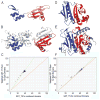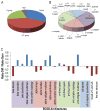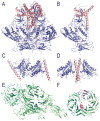CASP 11 target classification
- PMID: 26756794
- PMCID: PMC4940306
- DOI: 10.1002/prot.24982
CASP 11 target classification
Abstract
Protein target structures for the Critical Assessment of Structure Prediction round 11 (CASP11) and CASP ROLL were split into domains and classified into categories suitable for assessment of template-based modeling (TBM) and free modeling (FM) based on their evolutionary relatedness to existing structures classified by the Evolutionary Classification of Protein Domains (ECOD) database. First, target structures were divided into domain-based evaluation units. Target splits were based on the domain organization of available templates as well as the performance of servers on whole targets compared to split target domains. Second, evaluation units were classified into TBM and FM categories using a combination of measures that evaluate prediction quality and template detectability. Generally, target domains with sequence-related templates and good server prediction performance were classified as TBM, whereas targets without sequence-identifiable templates and low server performance were classified as FM. As in previous CASP experiments, the boundaries for classification were blurred due to the presence of significant insertions and deteriorations in the targets with respect to homologous templates, as well as the presence of templates with partial coverage of new folds. The FM category included 45 target domains, which represents an unprecedented number of difficult CASP targets provided for modeling. Proteins 2016; 84(Suppl 1):20-33. © 2016 Wiley Periodicals, Inc.
Keywords: CASP11; classification; fold space; free modeling; protein structure; sequence homologs; structure analogs; structure prediction; template-based modeling.
© 2016 Wiley Periodicals, Inc.
Figures







References
Publication types
MeSH terms
Substances
Grants and funding
LinkOut - more resources
Full Text Sources
Other Literature Sources
Research Materials

